Company Law: Business Structures, Liability, and Consumer Law
VerifiedAdded on 2023/06/13
|11
|2342
|230
AI Summary
This article discusses the different business structures in Australia, including sole trader, company, partnership, and trust. It also covers the liability of directors and partners, financial contribution and distribution in partnerships, and the legal obligations of a group to an independent contractor. Additionally, it explains the Australian Consumer Law and the liability of principals to independent contractors and third parties.
Contribute Materials
Your contribution can guide someone’s learning journey. Share your
documents today.
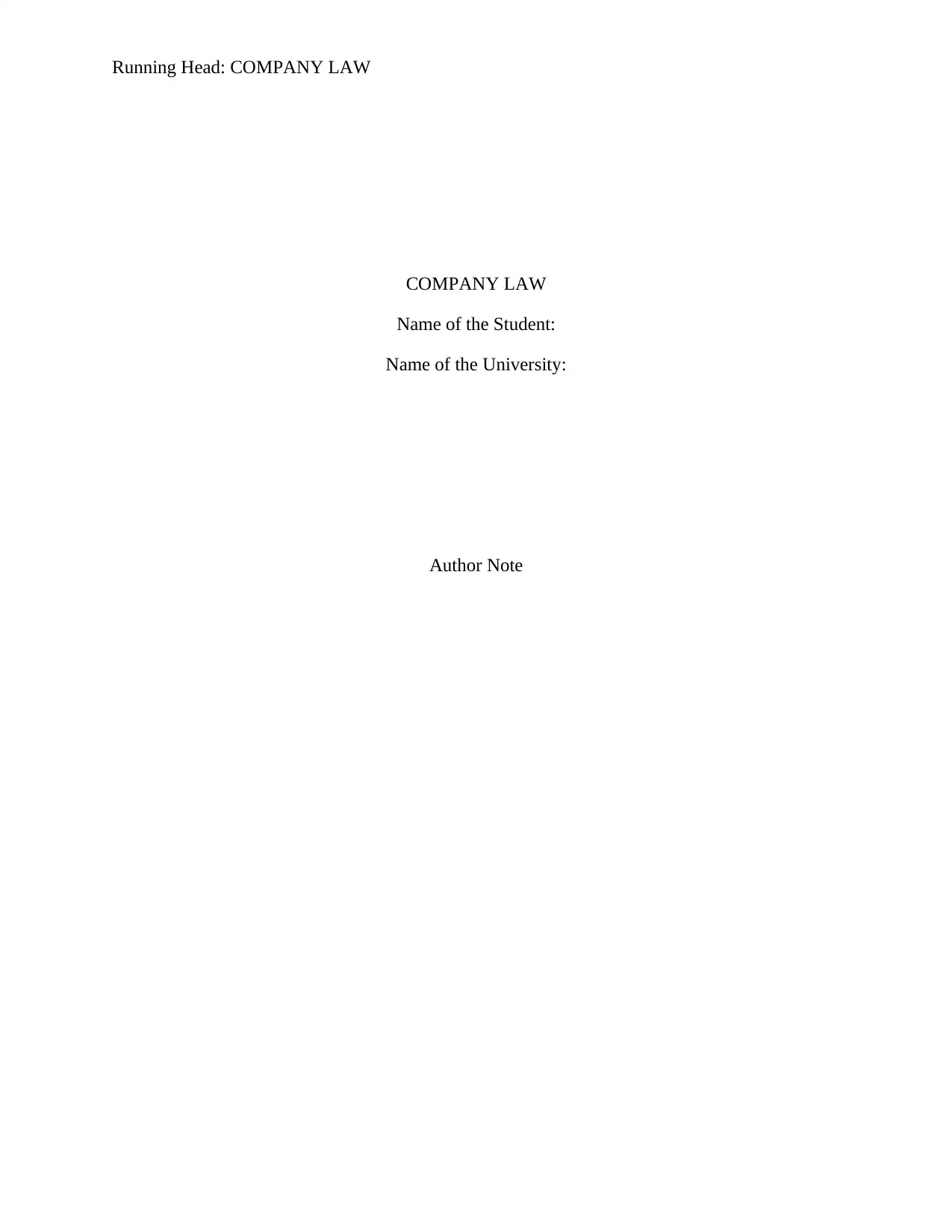
Running Head: COMPANY LAW
COMPANY LAW
Name of the Student:
Name of the University:
Author Note
COMPANY LAW
Name of the Student:
Name of the University:
Author Note
Secure Best Marks with AI Grader
Need help grading? Try our AI Grader for instant feedback on your assignments.
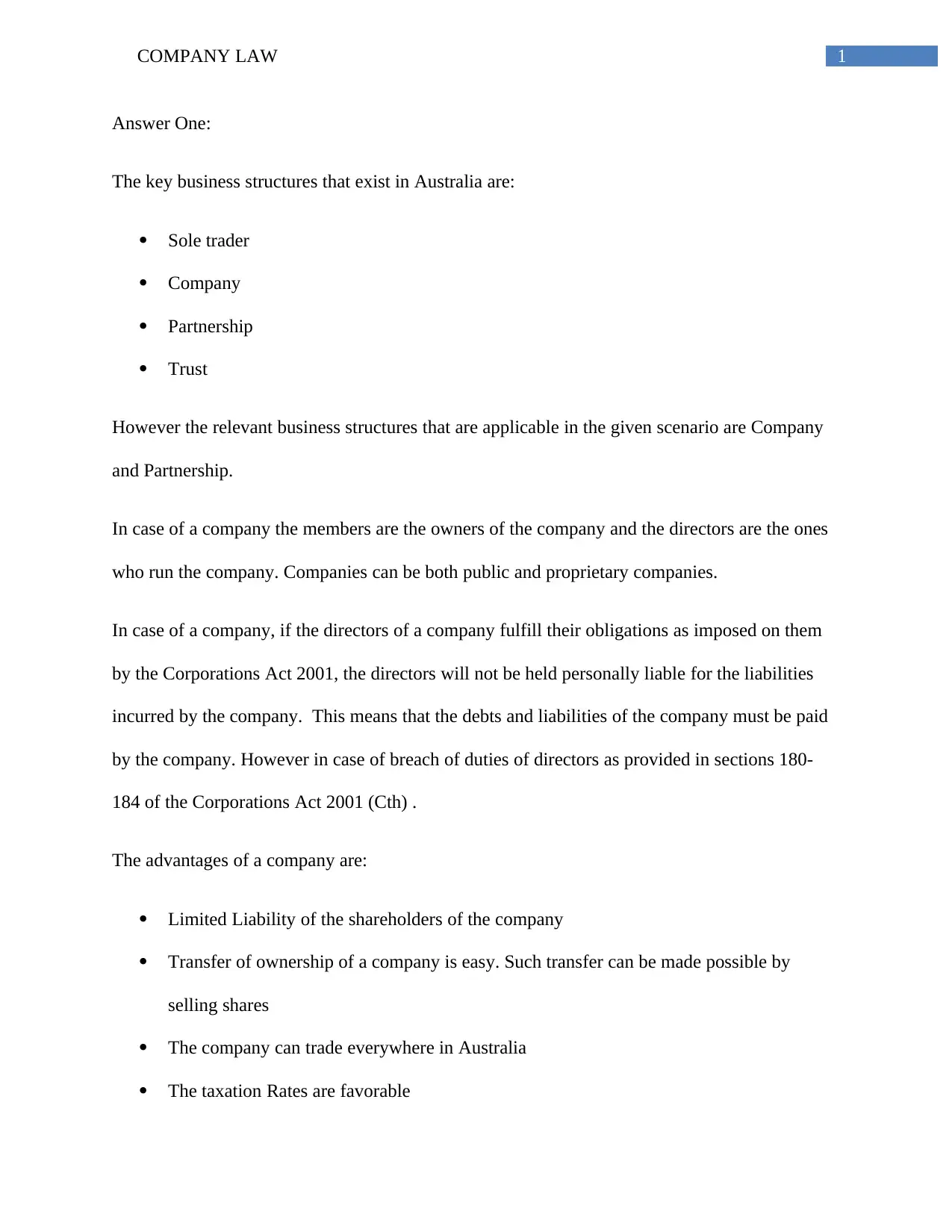
1COMPANY LAW
Answer One:
The key business structures that exist in Australia are:
Sole trader
Company
Partnership
Trust
However the relevant business structures that are applicable in the given scenario are Company
and Partnership.
In case of a company the members are the owners of the company and the directors are the ones
who run the company. Companies can be both public and proprietary companies.
In case of a company, if the directors of a company fulfill their obligations as imposed on them
by the Corporations Act 2001, the directors will not be held personally liable for the liabilities
incurred by the company. This means that the debts and liabilities of the company must be paid
by the company. However in case of breach of duties of directors as provided in sections 180-
184 of the Corporations Act 2001 (Cth) .
The advantages of a company are:
Limited Liability of the shareholders of the company
Transfer of ownership of a company is easy. Such transfer can be made possible by
selling shares
The company can trade everywhere in Australia
The taxation Rates are favorable
Answer One:
The key business structures that exist in Australia are:
Sole trader
Company
Partnership
Trust
However the relevant business structures that are applicable in the given scenario are Company
and Partnership.
In case of a company the members are the owners of the company and the directors are the ones
who run the company. Companies can be both public and proprietary companies.
In case of a company, if the directors of a company fulfill their obligations as imposed on them
by the Corporations Act 2001, the directors will not be held personally liable for the liabilities
incurred by the company. This means that the debts and liabilities of the company must be paid
by the company. However in case of breach of duties of directors as provided in sections 180-
184 of the Corporations Act 2001 (Cth) .
The advantages of a company are:
Limited Liability of the shareholders of the company
Transfer of ownership of a company is easy. Such transfer can be made possible by
selling shares
The company can trade everywhere in Australia
The taxation Rates are favorable
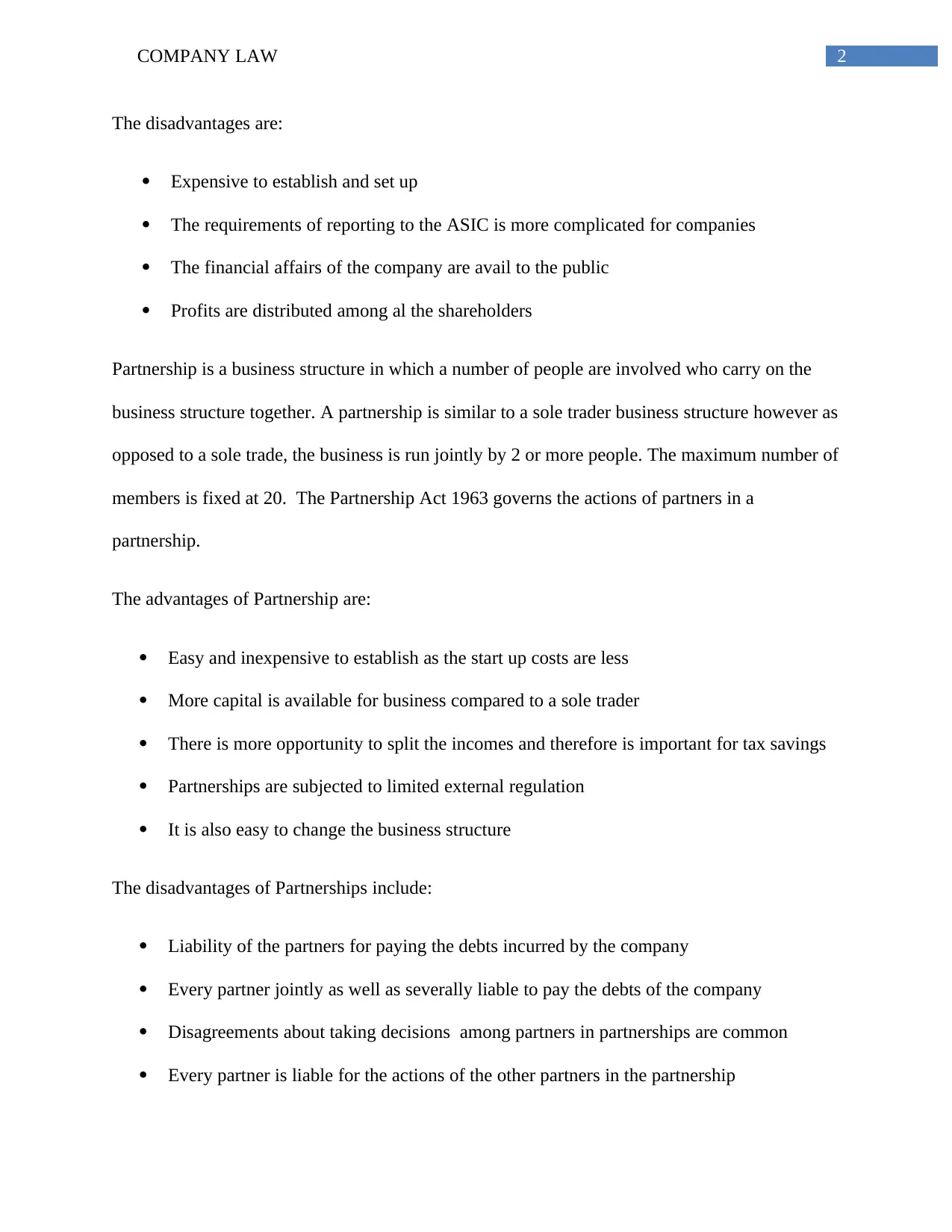
2COMPANY LAW
The disadvantages are:
Expensive to establish and set up
The requirements of reporting to the ASIC is more complicated for companies
The financial affairs of the company are avail to the public
Profits are distributed among al the shareholders
Partnership is a business structure in which a number of people are involved who carry on the
business structure together. A partnership is similar to a sole trader business structure however as
opposed to a sole trade, the business is run jointly by 2 or more people. The maximum number of
members is fixed at 20. The Partnership Act 1963 governs the actions of partners in a
partnership.
The advantages of Partnership are:
Easy and inexpensive to establish as the start up costs are less
More capital is available for business compared to a sole trader
There is more opportunity to split the incomes and therefore is important for tax savings
Partnerships are subjected to limited external regulation
It is also easy to change the business structure
The disadvantages of Partnerships include:
Liability of the partners for paying the debts incurred by the company
Every partner jointly as well as severally liable to pay the debts of the company
Disagreements about taking decisions among partners in partnerships are common
Every partner is liable for the actions of the other partners in the partnership
The disadvantages are:
Expensive to establish and set up
The requirements of reporting to the ASIC is more complicated for companies
The financial affairs of the company are avail to the public
Profits are distributed among al the shareholders
Partnership is a business structure in which a number of people are involved who carry on the
business structure together. A partnership is similar to a sole trader business structure however as
opposed to a sole trade, the business is run jointly by 2 or more people. The maximum number of
members is fixed at 20. The Partnership Act 1963 governs the actions of partners in a
partnership.
The advantages of Partnership are:
Easy and inexpensive to establish as the start up costs are less
More capital is available for business compared to a sole trader
There is more opportunity to split the incomes and therefore is important for tax savings
Partnerships are subjected to limited external regulation
It is also easy to change the business structure
The disadvantages of Partnerships include:
Liability of the partners for paying the debts incurred by the company
Every partner jointly as well as severally liable to pay the debts of the company
Disagreements about taking decisions among partners in partnerships are common
Every partner is liable for the actions of the other partners in the partnership
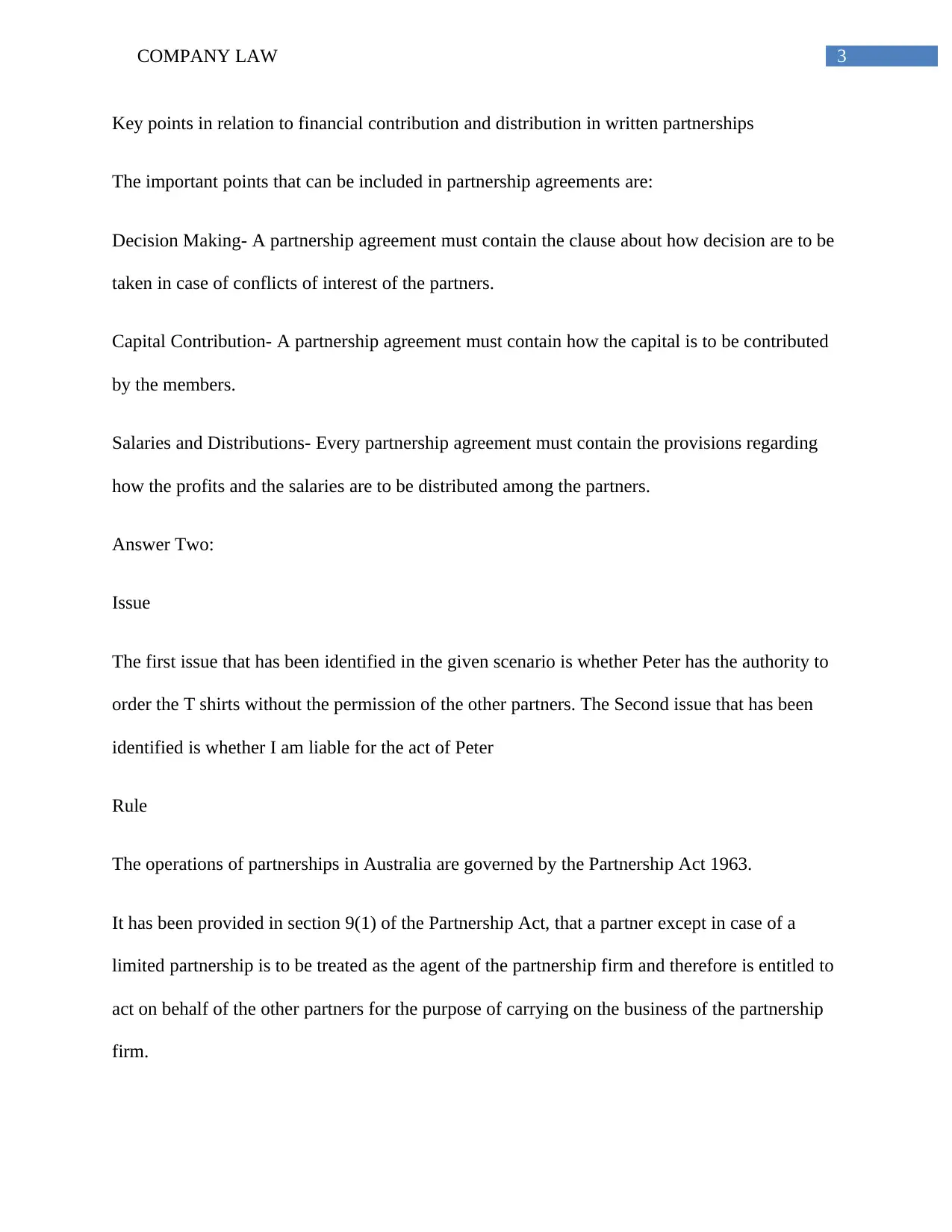
3COMPANY LAW
Key points in relation to financial contribution and distribution in written partnerships
The important points that can be included in partnership agreements are:
Decision Making- A partnership agreement must contain the clause about how decision are to be
taken in case of conflicts of interest of the partners.
Capital Contribution- A partnership agreement must contain how the capital is to be contributed
by the members.
Salaries and Distributions- Every partnership agreement must contain the provisions regarding
how the profits and the salaries are to be distributed among the partners.
Answer Two:
Issue
The first issue that has been identified in the given scenario is whether Peter has the authority to
order the T shirts without the permission of the other partners. The Second issue that has been
identified is whether I am liable for the act of Peter
Rule
The operations of partnerships in Australia are governed by the Partnership Act 1963.
It has been provided in section 9(1) of the Partnership Act, that a partner except in case of a
limited partnership is to be treated as the agent of the partnership firm and therefore is entitled to
act on behalf of the other partners for the purpose of carrying on the business of the partnership
firm.
Key points in relation to financial contribution and distribution in written partnerships
The important points that can be included in partnership agreements are:
Decision Making- A partnership agreement must contain the clause about how decision are to be
taken in case of conflicts of interest of the partners.
Capital Contribution- A partnership agreement must contain how the capital is to be contributed
by the members.
Salaries and Distributions- Every partnership agreement must contain the provisions regarding
how the profits and the salaries are to be distributed among the partners.
Answer Two:
Issue
The first issue that has been identified in the given scenario is whether Peter has the authority to
order the T shirts without the permission of the other partners. The Second issue that has been
identified is whether I am liable for the act of Peter
Rule
The operations of partnerships in Australia are governed by the Partnership Act 1963.
It has been provided in section 9(1) of the Partnership Act, that a partner except in case of a
limited partnership is to be treated as the agent of the partnership firm and therefore is entitled to
act on behalf of the other partners for the purpose of carrying on the business of the partnership
firm.
Secure Best Marks with AI Grader
Need help grading? Try our AI Grader for instant feedback on your assignments.
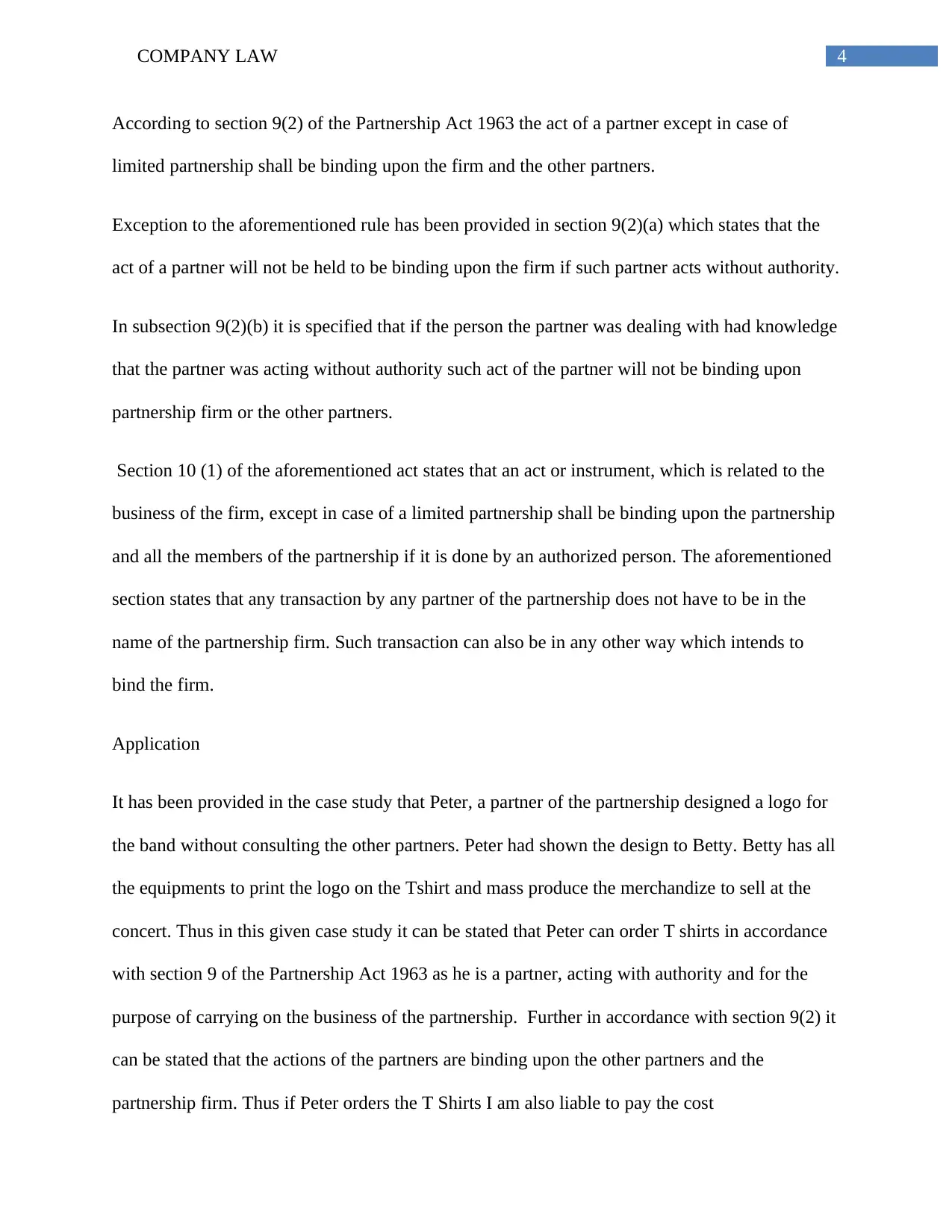
4COMPANY LAW
According to section 9(2) of the Partnership Act 1963 the act of a partner except in case of
limited partnership shall be binding upon the firm and the other partners.
Exception to the aforementioned rule has been provided in section 9(2)(a) which states that the
act of a partner will not be held to be binding upon the firm if such partner acts without authority.
In subsection 9(2)(b) it is specified that if the person the partner was dealing with had knowledge
that the partner was acting without authority such act of the partner will not be binding upon
partnership firm or the other partners.
Section 10 (1) of the aforementioned act states that an act or instrument, which is related to the
business of the firm, except in case of a limited partnership shall be binding upon the partnership
and all the members of the partnership if it is done by an authorized person. The aforementioned
section states that any transaction by any partner of the partnership does not have to be in the
name of the partnership firm. Such transaction can also be in any other way which intends to
bind the firm.
Application
It has been provided in the case study that Peter, a partner of the partnership designed a logo for
the band without consulting the other partners. Peter had shown the design to Betty. Betty has all
the equipments to print the logo on the Tshirt and mass produce the merchandize to sell at the
concert. Thus in this given case study it can be stated that Peter can order T shirts in accordance
with section 9 of the Partnership Act 1963 as he is a partner, acting with authority and for the
purpose of carrying on the business of the partnership. Further in accordance with section 9(2) it
can be stated that the actions of the partners are binding upon the other partners and the
partnership firm. Thus if Peter orders the T Shirts I am also liable to pay the cost
According to section 9(2) of the Partnership Act 1963 the act of a partner except in case of
limited partnership shall be binding upon the firm and the other partners.
Exception to the aforementioned rule has been provided in section 9(2)(a) which states that the
act of a partner will not be held to be binding upon the firm if such partner acts without authority.
In subsection 9(2)(b) it is specified that if the person the partner was dealing with had knowledge
that the partner was acting without authority such act of the partner will not be binding upon
partnership firm or the other partners.
Section 10 (1) of the aforementioned act states that an act or instrument, which is related to the
business of the firm, except in case of a limited partnership shall be binding upon the partnership
and all the members of the partnership if it is done by an authorized person. The aforementioned
section states that any transaction by any partner of the partnership does not have to be in the
name of the partnership firm. Such transaction can also be in any other way which intends to
bind the firm.
Application
It has been provided in the case study that Peter, a partner of the partnership designed a logo for
the band without consulting the other partners. Peter had shown the design to Betty. Betty has all
the equipments to print the logo on the Tshirt and mass produce the merchandize to sell at the
concert. Thus in this given case study it can be stated that Peter can order T shirts in accordance
with section 9 of the Partnership Act 1963 as he is a partner, acting with authority and for the
purpose of carrying on the business of the partnership. Further in accordance with section 9(2) it
can be stated that the actions of the partners are binding upon the other partners and the
partnership firm. Thus if Peter orders the T Shirts I am also liable to pay the cost
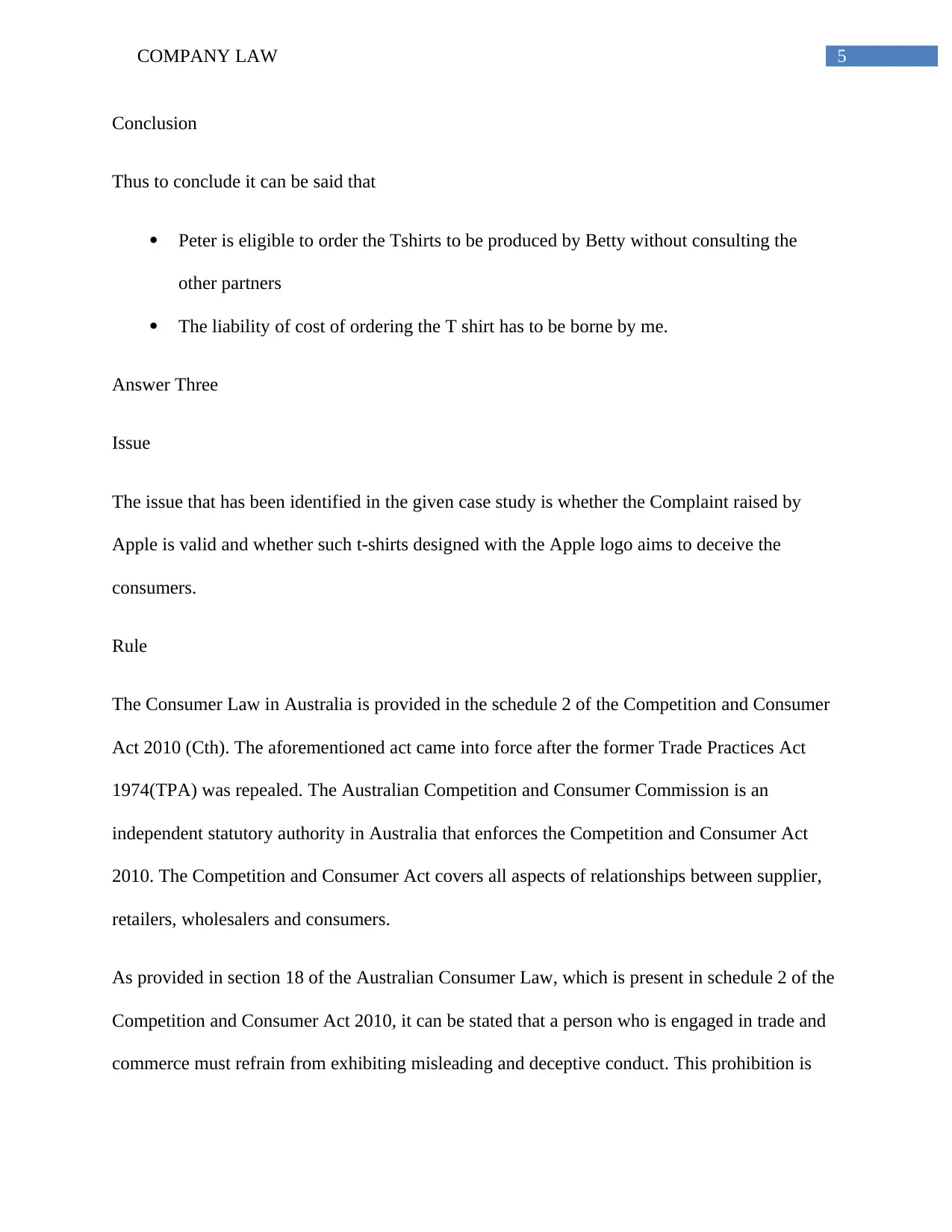
5COMPANY LAW
Conclusion
Thus to conclude it can be said that
Peter is eligible to order the Tshirts to be produced by Betty without consulting the
other partners
The liability of cost of ordering the T shirt has to be borne by me.
Answer Three
Issue
The issue that has been identified in the given case study is whether the Complaint raised by
Apple is valid and whether such t-shirts designed with the Apple logo aims to deceive the
consumers.
Rule
The Consumer Law in Australia is provided in the schedule 2 of the Competition and Consumer
Act 2010 (Cth). The aforementioned act came into force after the former Trade Practices Act
1974(TPA) was repealed. The Australian Competition and Consumer Commission is an
independent statutory authority in Australia that enforces the Competition and Consumer Act
2010. The Competition and Consumer Act covers all aspects of relationships between supplier,
retailers, wholesalers and consumers.
As provided in section 18 of the Australian Consumer Law, which is present in schedule 2 of the
Competition and Consumer Act 2010, it can be stated that a person who is engaged in trade and
commerce must refrain from exhibiting misleading and deceptive conduct. This prohibition is
Conclusion
Thus to conclude it can be said that
Peter is eligible to order the Tshirts to be produced by Betty without consulting the
other partners
The liability of cost of ordering the T shirt has to be borne by me.
Answer Three
Issue
The issue that has been identified in the given case study is whether the Complaint raised by
Apple is valid and whether such t-shirts designed with the Apple logo aims to deceive the
consumers.
Rule
The Consumer Law in Australia is provided in the schedule 2 of the Competition and Consumer
Act 2010 (Cth). The aforementioned act came into force after the former Trade Practices Act
1974(TPA) was repealed. The Australian Competition and Consumer Commission is an
independent statutory authority in Australia that enforces the Competition and Consumer Act
2010. The Competition and Consumer Act covers all aspects of relationships between supplier,
retailers, wholesalers and consumers.
As provided in section 18 of the Australian Consumer Law, which is present in schedule 2 of the
Competition and Consumer Act 2010, it can be stated that a person who is engaged in trade and
commerce must refrain from exhibiting misleading and deceptive conduct. This prohibition is
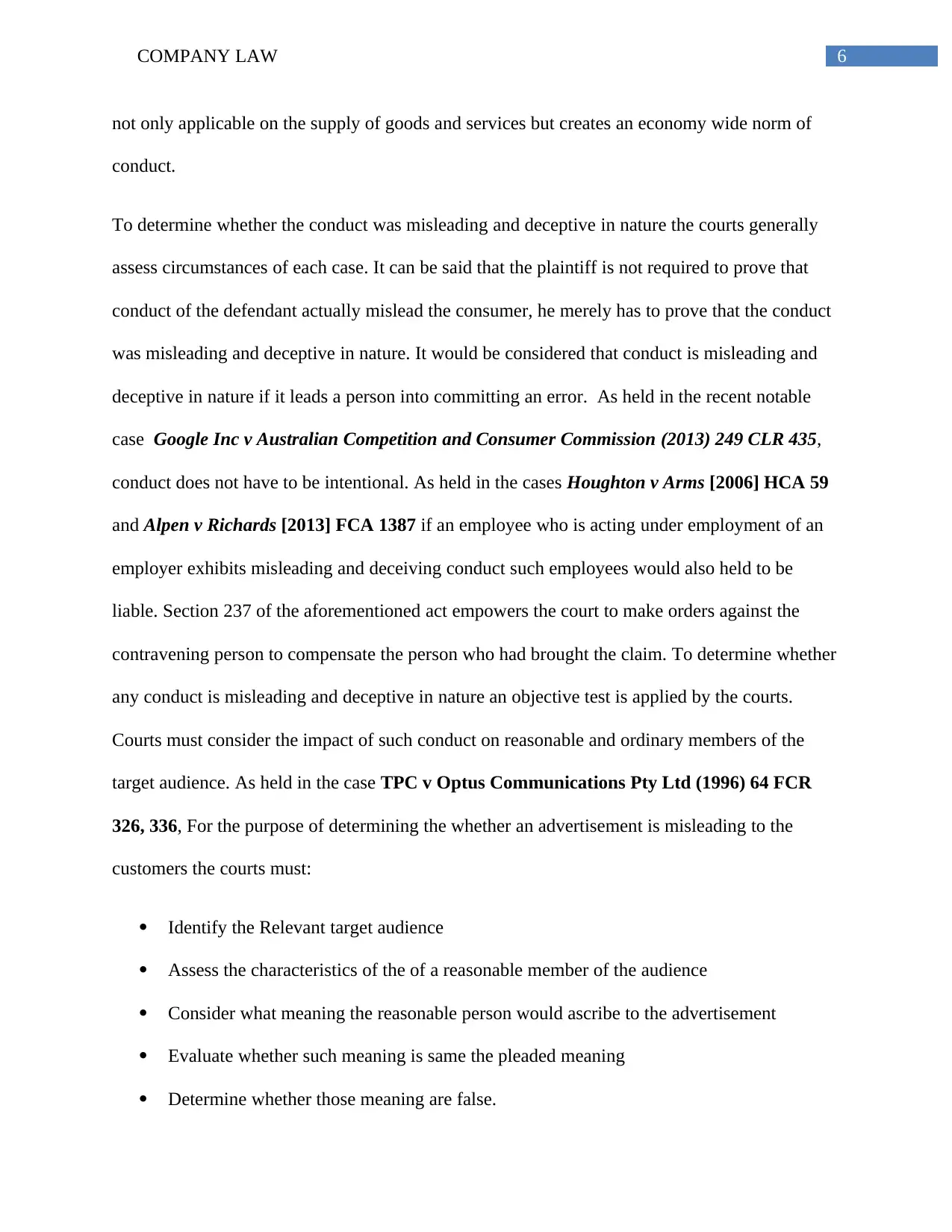
6COMPANY LAW
not only applicable on the supply of goods and services but creates an economy wide norm of
conduct.
To determine whether the conduct was misleading and deceptive in nature the courts generally
assess circumstances of each case. It can be said that the plaintiff is not required to prove that
conduct of the defendant actually mislead the consumer, he merely has to prove that the conduct
was misleading and deceptive in nature. It would be considered that conduct is misleading and
deceptive in nature if it leads a person into committing an error. As held in the recent notable
case Google Inc v Australian Competition and Consumer Commission (2013) 249 CLR 435,
conduct does not have to be intentional. As held in the cases Houghton v Arms [2006] HCA 59
and Alpen v Richards [2013] FCA 1387 if an employee who is acting under employment of an
employer exhibits misleading and deceiving conduct such employees would also held to be
liable. Section 237 of the aforementioned act empowers the court to make orders against the
contravening person to compensate the person who had brought the claim. To determine whether
any conduct is misleading and deceptive in nature an objective test is applied by the courts.
Courts must consider the impact of such conduct on reasonable and ordinary members of the
target audience. As held in the case TPC v Optus Communications Pty Ltd (1996) 64 FCR
326, 336, For the purpose of determining the whether an advertisement is misleading to the
customers the courts must:
Identify the Relevant target audience
Assess the characteristics of the of a reasonable member of the audience
Consider what meaning the reasonable person would ascribe to the advertisement
Evaluate whether such meaning is same the pleaded meaning
Determine whether those meaning are false.
not only applicable on the supply of goods and services but creates an economy wide norm of
conduct.
To determine whether the conduct was misleading and deceptive in nature the courts generally
assess circumstances of each case. It can be said that the plaintiff is not required to prove that
conduct of the defendant actually mislead the consumer, he merely has to prove that the conduct
was misleading and deceptive in nature. It would be considered that conduct is misleading and
deceptive in nature if it leads a person into committing an error. As held in the recent notable
case Google Inc v Australian Competition and Consumer Commission (2013) 249 CLR 435,
conduct does not have to be intentional. As held in the cases Houghton v Arms [2006] HCA 59
and Alpen v Richards [2013] FCA 1387 if an employee who is acting under employment of an
employer exhibits misleading and deceiving conduct such employees would also held to be
liable. Section 237 of the aforementioned act empowers the court to make orders against the
contravening person to compensate the person who had brought the claim. To determine whether
any conduct is misleading and deceptive in nature an objective test is applied by the courts.
Courts must consider the impact of such conduct on reasonable and ordinary members of the
target audience. As held in the case TPC v Optus Communications Pty Ltd (1996) 64 FCR
326, 336, For the purpose of determining the whether an advertisement is misleading to the
customers the courts must:
Identify the Relevant target audience
Assess the characteristics of the of a reasonable member of the audience
Consider what meaning the reasonable person would ascribe to the advertisement
Evaluate whether such meaning is same the pleaded meaning
Determine whether those meaning are false.
Paraphrase This Document
Need a fresh take? Get an instant paraphrase of this document with our AI Paraphraser
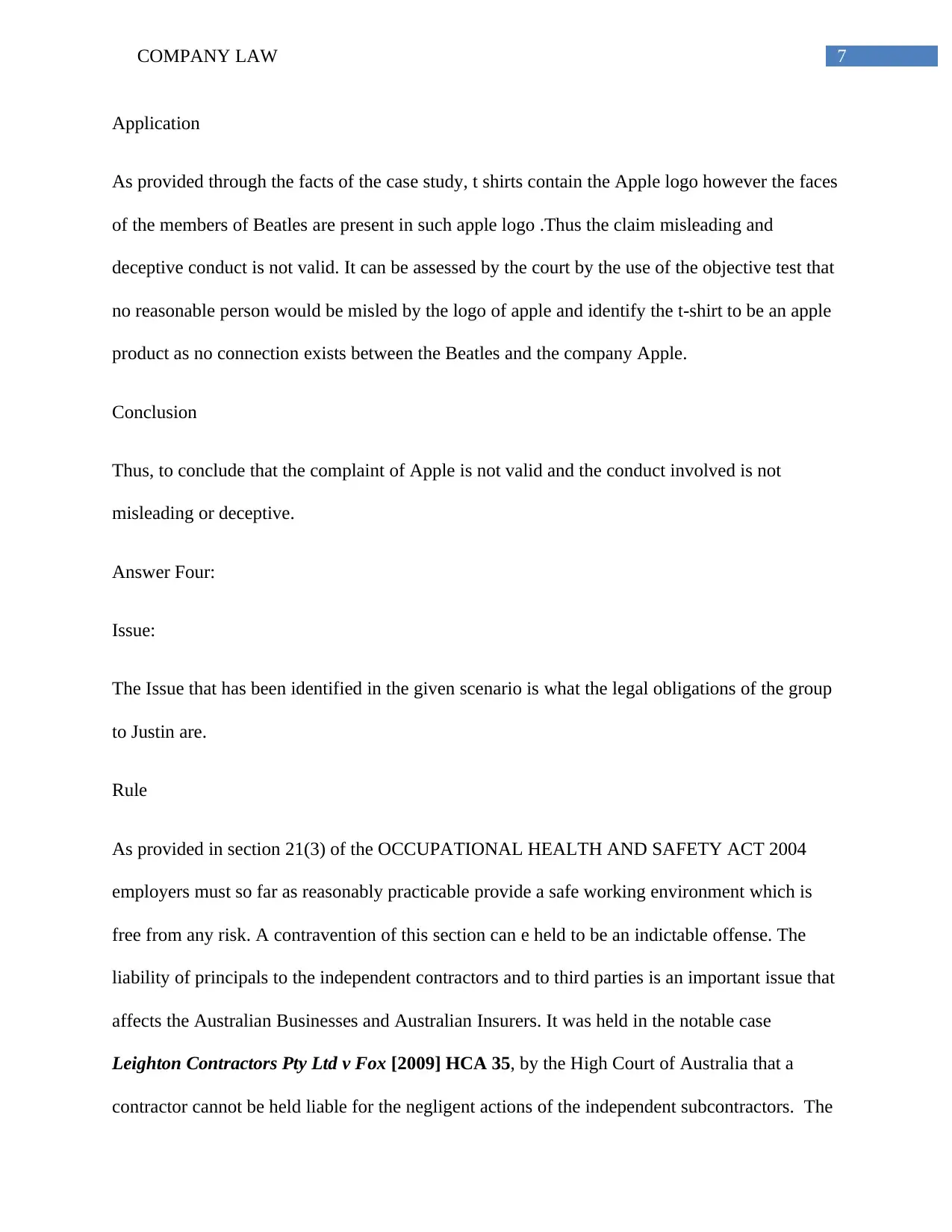
7COMPANY LAW
Application
As provided through the facts of the case study, t shirts contain the Apple logo however the faces
of the members of Beatles are present in such apple logo .Thus the claim misleading and
deceptive conduct is not valid. It can be assessed by the court by the use of the objective test that
no reasonable person would be misled by the logo of apple and identify the t-shirt to be an apple
product as no connection exists between the Beatles and the company Apple.
Conclusion
Thus, to conclude that the complaint of Apple is not valid and the conduct involved is not
misleading or deceptive.
Answer Four:
Issue:
The Issue that has been identified in the given scenario is what the legal obligations of the group
to Justin are.
Rule
As provided in section 21(3) of the OCCUPATIONAL HEALTH AND SAFETY ACT 2004
employers must so far as reasonably practicable provide a safe working environment which is
free from any risk. A contravention of this section can e held to be an indictable offense. The
liability of principals to the independent contractors and to third parties is an important issue that
affects the Australian Businesses and Australian Insurers. It was held in the notable case
Leighton Contractors Pty Ltd v Fox [2009] HCA 35, by the High Court of Australia that a
contractor cannot be held liable for the negligent actions of the independent subcontractors. The
Application
As provided through the facts of the case study, t shirts contain the Apple logo however the faces
of the members of Beatles are present in such apple logo .Thus the claim misleading and
deceptive conduct is not valid. It can be assessed by the court by the use of the objective test that
no reasonable person would be misled by the logo of apple and identify the t-shirt to be an apple
product as no connection exists between the Beatles and the company Apple.
Conclusion
Thus, to conclude that the complaint of Apple is not valid and the conduct involved is not
misleading or deceptive.
Answer Four:
Issue:
The Issue that has been identified in the given scenario is what the legal obligations of the group
to Justin are.
Rule
As provided in section 21(3) of the OCCUPATIONAL HEALTH AND SAFETY ACT 2004
employers must so far as reasonably practicable provide a safe working environment which is
free from any risk. A contravention of this section can e held to be an indictable offense. The
liability of principals to the independent contractors and to third parties is an important issue that
affects the Australian Businesses and Australian Insurers. It was held in the notable case
Leighton Contractors Pty Ltd v Fox [2009] HCA 35, by the High Court of Australia that a
contractor cannot be held liable for the negligent actions of the independent subcontractors. The
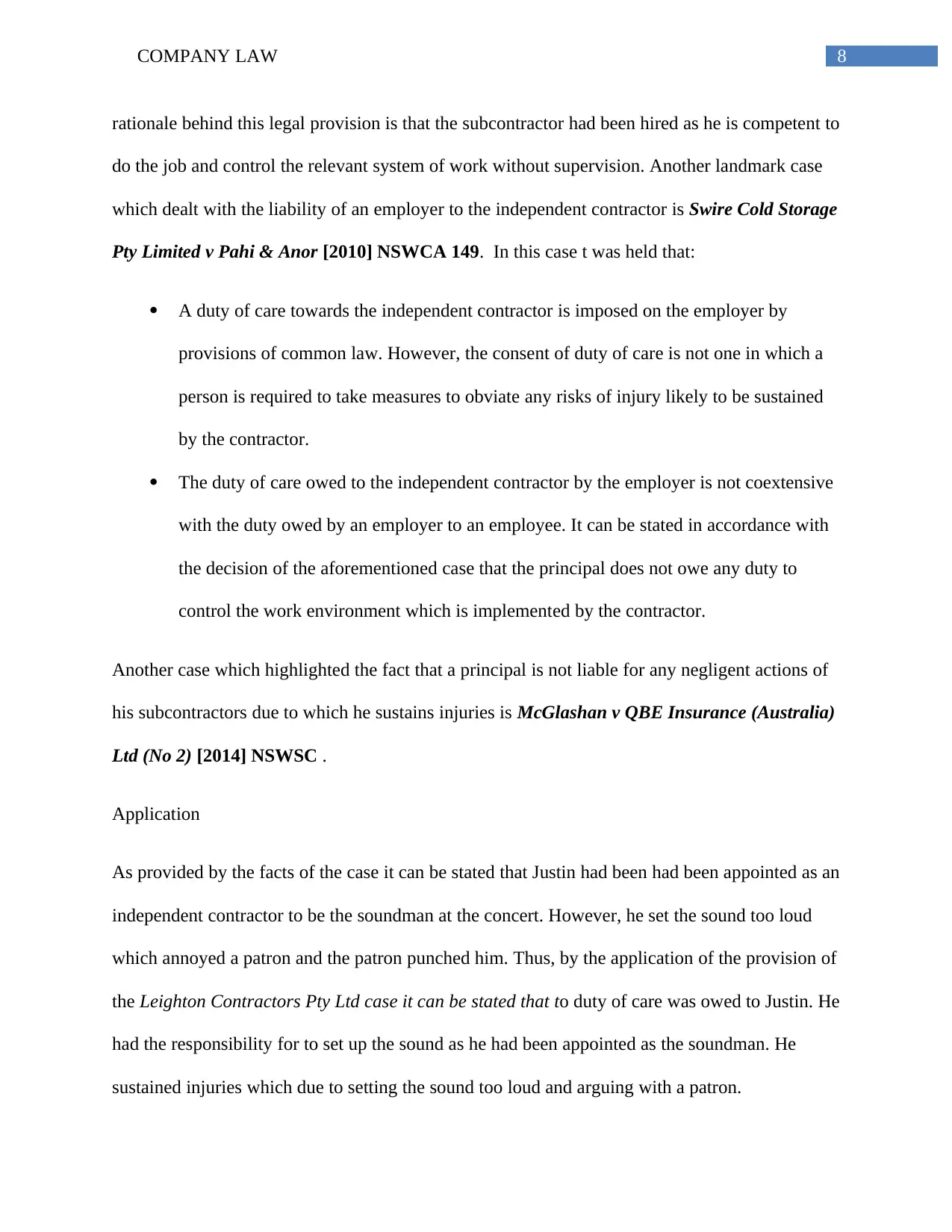
8COMPANY LAW
rationale behind this legal provision is that the subcontractor had been hired as he is competent to
do the job and control the relevant system of work without supervision. Another landmark case
which dealt with the liability of an employer to the independent contractor is Swire Cold Storage
Pty Limited v Pahi & Anor [2010] NSWCA 149. In this case t was held that:
A duty of care towards the independent contractor is imposed on the employer by
provisions of common law. However, the consent of duty of care is not one in which a
person is required to take measures to obviate any risks of injury likely to be sustained
by the contractor.
The duty of care owed to the independent contractor by the employer is not coextensive
with the duty owed by an employer to an employee. It can be stated in accordance with
the decision of the aforementioned case that the principal does not owe any duty to
control the work environment which is implemented by the contractor.
Another case which highlighted the fact that a principal is not liable for any negligent actions of
his subcontractors due to which he sustains injuries is McGlashan v QBE Insurance (Australia)
Ltd (No 2) [2014] NSWSC .
Application
As provided by the facts of the case it can be stated that Justin had been had been appointed as an
independent contractor to be the soundman at the concert. However, he set the sound too loud
which annoyed a patron and the patron punched him. Thus, by the application of the provision of
the Leighton Contractors Pty Ltd case it can be stated that to duty of care was owed to Justin. He
had the responsibility for to set up the sound as he had been appointed as the soundman. He
sustained injuries which due to setting the sound too loud and arguing with a patron.
rationale behind this legal provision is that the subcontractor had been hired as he is competent to
do the job and control the relevant system of work without supervision. Another landmark case
which dealt with the liability of an employer to the independent contractor is Swire Cold Storage
Pty Limited v Pahi & Anor [2010] NSWCA 149. In this case t was held that:
A duty of care towards the independent contractor is imposed on the employer by
provisions of common law. However, the consent of duty of care is not one in which a
person is required to take measures to obviate any risks of injury likely to be sustained
by the contractor.
The duty of care owed to the independent contractor by the employer is not coextensive
with the duty owed by an employer to an employee. It can be stated in accordance with
the decision of the aforementioned case that the principal does not owe any duty to
control the work environment which is implemented by the contractor.
Another case which highlighted the fact that a principal is not liable for any negligent actions of
his subcontractors due to which he sustains injuries is McGlashan v QBE Insurance (Australia)
Ltd (No 2) [2014] NSWSC .
Application
As provided by the facts of the case it can be stated that Justin had been had been appointed as an
independent contractor to be the soundman at the concert. However, he set the sound too loud
which annoyed a patron and the patron punched him. Thus, by the application of the provision of
the Leighton Contractors Pty Ltd case it can be stated that to duty of care was owed to Justin. He
had the responsibility for to set up the sound as he had been appointed as the soundman. He
sustained injuries which due to setting the sound too loud and arguing with a patron.
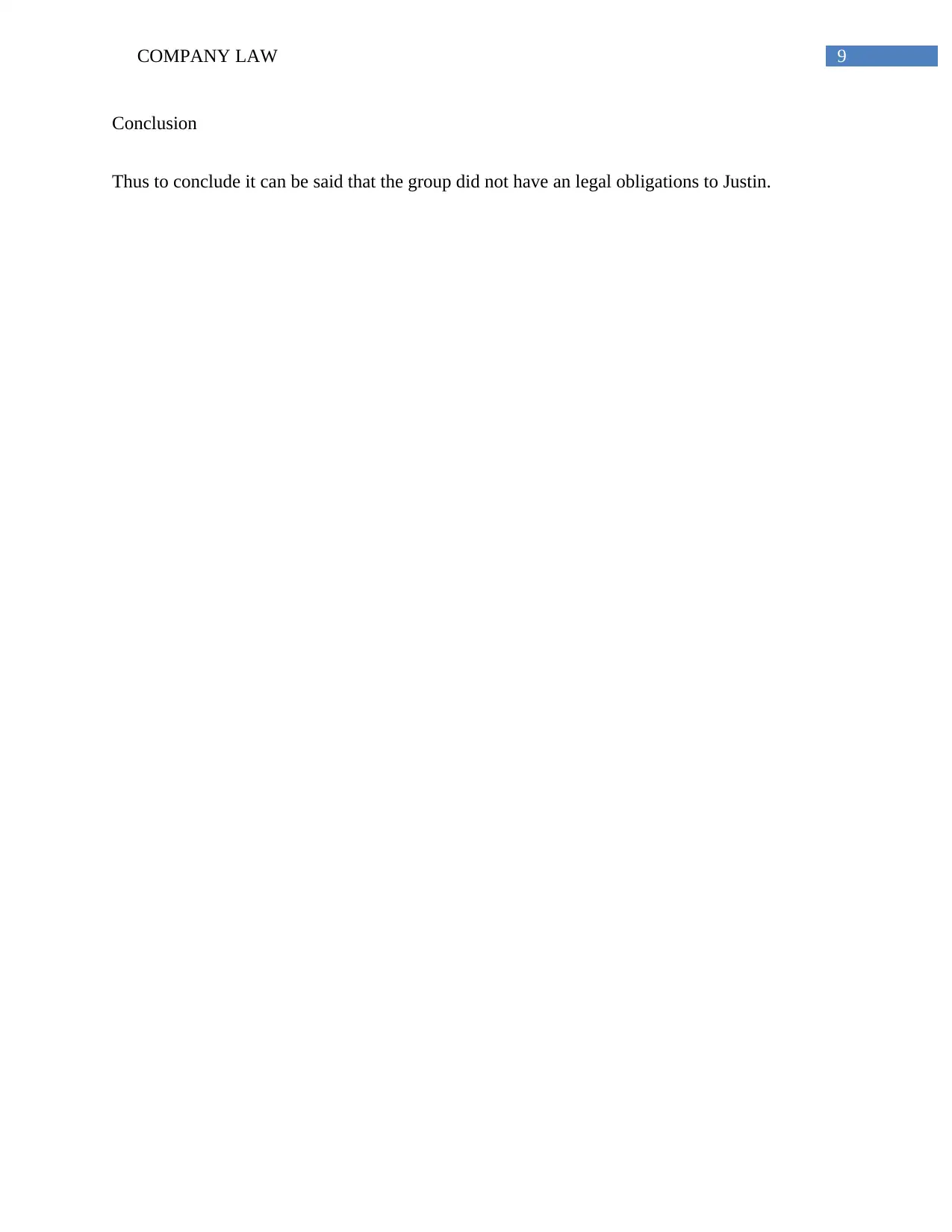
9COMPANY LAW
Conclusion
Thus to conclude it can be said that the group did not have an legal obligations to Justin.
Conclusion
Thus to conclude it can be said that the group did not have an legal obligations to Justin.
Secure Best Marks with AI Grader
Need help grading? Try our AI Grader for instant feedback on your assignments.
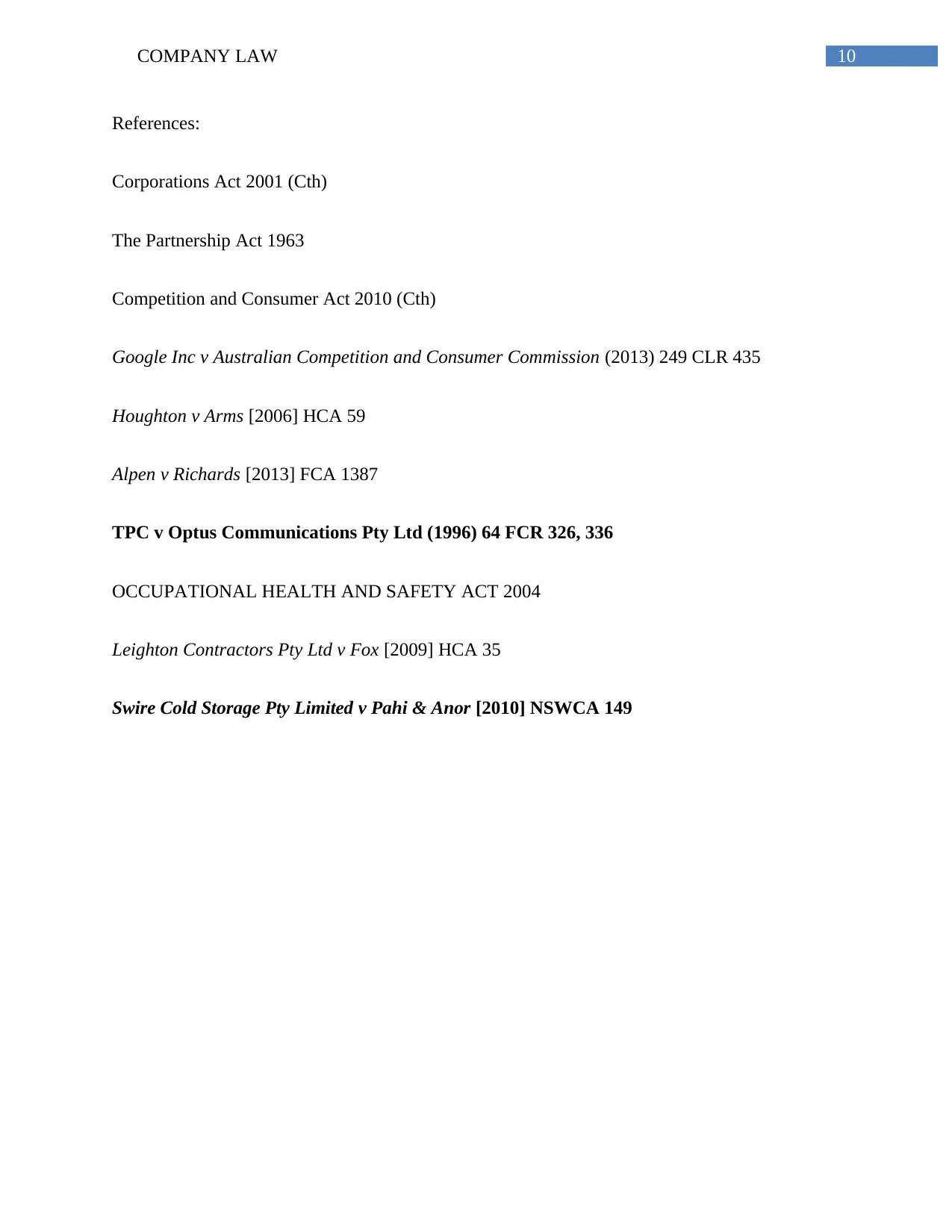
10COMPANY LAW
References:
Corporations Act 2001 (Cth)
The Partnership Act 1963
Competition and Consumer Act 2010 (Cth)
Google Inc v Australian Competition and Consumer Commission (2013) 249 CLR 435
Houghton v Arms [2006] HCA 59
Alpen v Richards [2013] FCA 1387
TPC v Optus Communications Pty Ltd (1996) 64 FCR 326, 336
OCCUPATIONAL HEALTH AND SAFETY ACT 2004
Leighton Contractors Pty Ltd v Fox [2009] HCA 35
Swire Cold Storage Pty Limited v Pahi & Anor [2010] NSWCA 149
References:
Corporations Act 2001 (Cth)
The Partnership Act 1963
Competition and Consumer Act 2010 (Cth)
Google Inc v Australian Competition and Consumer Commission (2013) 249 CLR 435
Houghton v Arms [2006] HCA 59
Alpen v Richards [2013] FCA 1387
TPC v Optus Communications Pty Ltd (1996) 64 FCR 326, 336
OCCUPATIONAL HEALTH AND SAFETY ACT 2004
Leighton Contractors Pty Ltd v Fox [2009] HCA 35
Swire Cold Storage Pty Limited v Pahi & Anor [2010] NSWCA 149
1 out of 11
Related Documents
Your All-in-One AI-Powered Toolkit for Academic Success.
+13062052269
info@desklib.com
Available 24*7 on WhatsApp / Email
![[object Object]](/_next/static/media/star-bottom.7253800d.svg)
Unlock your academic potential
© 2024 | Zucol Services PVT LTD | All rights reserved.





